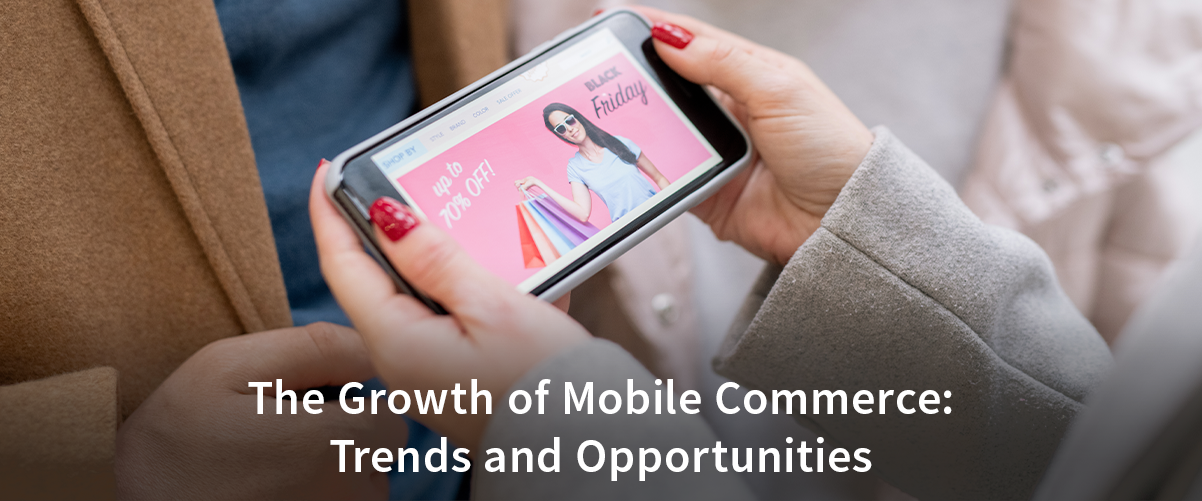
Mobile commerce, or m-commerce, is no longer a buzzword but a booming sector that is revolutionising the retail industry. With smartphones becoming an essential part of our lives, shopping on mobile devices has skyrocketed. But what are the trends driving this growth, and how can retailers tap into these opportunities? Let’s dive into the world of mobile commerce and explore its dynamic evolution.
What is Mobile Commerce and why does it matter?
Mobile commerce is a form of purchasing and selling of goods and services through mobile devices, such as smartphones and tablets. It can be anything from online shopping to mobile banking or in-app purchases.
Mobile commerce helps bridge the convenience gap with functionality, allowing people to shop anywhere, anytime. For businesses, it opens new avenues for interacting with customers and driving sales.
Key Trends Driving Growth in Mobile Commerce
- Emergence of Mobile Wallets: Mobile wallets like Apple Pay, Google Pay, and PayPal are changing the face of transactions. Their ease of use and safety have gained preference among several customers.
- Social Commerce: Social media applications are transforming into mini-markets. Facilities like Instagram Shop and Facebook Marketplace have enabled browsing, shopping, and payment directly through the app without leaving it.
- AI and Personalised Shopping Experience: Artificial Intelligence (AI) is helping retailers offer personalised recommendations based on browsing and purchase history, making the shopping experience more tailored and engaging.
- Voice-Activated Shopping: Voice assistants like Alexa and Google Assistant are enabling hands-free shopping. Customers can now search for products and place orders using simple voice commands.
- Augmented Reality (AR) in Mobile Commerce: AR technology lets consumers see products in real-world spaces. One example is virtual try-ons for glasses or how furniture would fit in a room through apps.
Opportunities in Mobile Commerce
- Increased Customer Base: Mobile commerce is an important method of bringing retailers to a wider market, including people in areas that have no shop as such due to its unavailability.
- Customer Engagement: Features such as push notifications, chatbots, and live streaming keep in touch with customers; it also motivates them to buy again.
- Leveraging Data Analytics: Data about customer shopping behavior can be analysed to refine the marketing strategy and have a better output.
- Cross-Border Commerce: Cross-border sales will become more manageable through mobile commerce as geospatial constraints reduce.
- Subscription-Based Models: The use of subscription services through applications could bring recurring revenues for the retailer, with predictable cash flows.
Challenges in Mobile Commerce
- Security Concerns: The concern is that most customers do not want to provide sensitive information over the internet. Retailers have to ensure a secure payment gateway and data protection mechanism.
- Mobile Optimisation: Responsive design, rapid loading time, and user-friendly navigation are needed for a smooth mobile experience.
- Increasing Competition: There is cutthroat competition in m-commerce. Thus, businesses must innovate to sustain this platform.
Role of Mobile Apps in M-Commerce
Mobile apps are the core of the mobile commerce revolution. They make the mobile user experience much more personalised and immersive than that of mobile websites. Features such as offline browsing, loyalty cards, and one-click checkouts make apps a must-have for today’s retailers.
Future of Mobile Commerce
- 5G Technology: Imagining the future is easier with the faster speeds of internet; this technology would make the video content quality, AR experiences, and app functionality more improved.
- Blockchain for Secure Transactions: Blockchain technology promises to make mobile transactions more secure and transparent, fostering trust among users.
- Sustainability in Mobile Commerce: Eco-conscious consumers are pushing retailers to adopt sustainable practices, such as carbon-neutral deliveries and eco-friendly products.
How ETP Unify Can Accelerate Mobile Commerce Success
ETP Unify, a powerful, cloud-native unified commerce retail platform by ETP Group, is designed to empower retailers in the mobile commerce space. Here’s how:
- Seamless Omni-channel Integration: ETP Unify provides a seamless shopping experience across mobile apps, websites, and physical stores.
- Real-Time Data Analytics: Leverage insights to understand customer behavior and offer personalised promotions.
- Scalable Solutions: The platform adapts to your business needs, whether you’re a small retailer or a global brand.
- Enhanced Customer Experience: With advanced features like mobile wallet integration and AI-driven recommendations, ETP Unify helps retailers deliver exceptional shopping experiences.
- Secure and Reliable: ETP Unify is made with top security measures for protecting the data of your customers at all times.
ETP Unify positions retailers to thrive in the fast-paced world of mobile commerce, ensuring they stay ahead of the curve.
The growth in mobile commerce is unstoppable, and its pace depends on technological advancements as well as the evolution of consumer behaviors. By staying ahead of the trends and embracing innovative solutions like ETP Unify, retailers can unlock unparalleled opportunities and secure a competitive edge in this rapidly evolving landscape.




